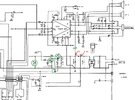baristini
Member
Hello to everyone.
I have a pcb board that stoped to work. I can find the problem...
Can anyone help me the to find the fault?
In attach i have the schematic of the board.
When conecting the board to power (9.5volt) i get power (9.5V) before D1 diode, but 0V after this diode.
Already replaced this diode and same result.
Disconected TR8 TR9 and LA4700 ( pins 14 and 5 ) and still have the same result....
TR8 and TR9 seem good. Replaced also LA4700 amp.
if someone have a clue or test to perform please let me know...
Thanks all!
I have a pcb board that stoped to work. I can find the problem...
Can anyone help me the to find the fault?
In attach i have the schematic of the board.
When conecting the board to power (9.5volt) i get power (9.5V) before D1 diode, but 0V after this diode.
Already replaced this diode and same result.
Disconected TR8 TR9 and LA4700 ( pins 14 and 5 ) and still have the same result....
TR8 and TR9 seem good. Replaced also LA4700 amp.
if someone have a clue or test to perform please let me know...
Thanks all!


